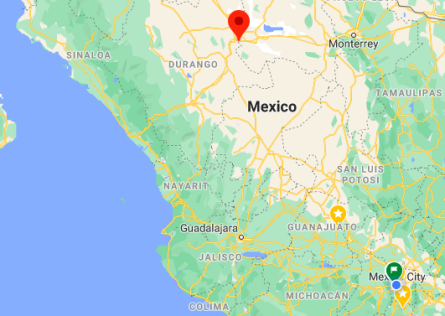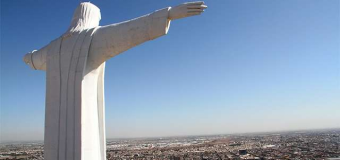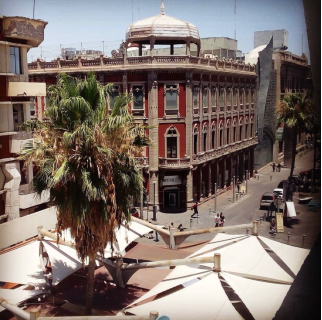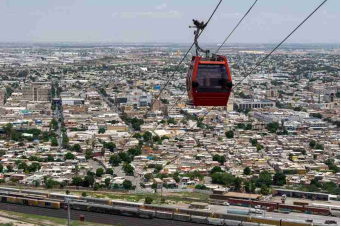Torreón, Coahuila 作者: 来源: 发布时间:2021-07-22
1. Basic data
Pop: 1,222,107 (metro)
Area: 272 km2
Elev: 1592 masl

2. Natural geography
The municipality of Torreón is at an average altitude of 1,120 meters above sea level, its northern sector is mostly flat, although a series of mountains, in which the Cerro de las Noas is located, surrounds the municipal head in its sector southwest, the rest is made up of plains that formerly formed the bed of the great Laguna de Mayrán. The southern sector of the municipality is much more rugged, characterized by the Sierra de Jimulco where the highest elevation of the municipality is found, Cerro El Centinela; also called "Cerro Las Nopaleras", 3,146 meters above sea level.
Torreón is completely included in an extensive geographical area that formerly constituted the closed basin of the Laguna de Mayrán, this was the largest of a large series of closed basins that characterize the desert region of northern Mexico, mainly in the states of Coahuila and Chihuahua, these basins harbor lagoons in the rainy season that later dry out due to evaporation and leave mineral deposits that are commercially exploited in several cases, such as salt flats.

The main fluvial currents of the municipality are the two main rivers that exist in Mexico with these characteristics: the Nazas River, whose source enters the municipality from the neighboring state of Durango and crossing the municipal head in a west-east direction, continuing towards the Laguna de Mayran , and the Aguanaval River, which comes from the state of Zacatecas marks the state boundary between Durango and Coahuila in the south-north direction in the southern sector of the municipality, later it turned east and also headed towards the Mayrán Lagoon.6 In the Currently both rivers are completely dry due to their diversion in dams in the states of Durango and Zacatecas with the intention of regulating their water avenues and especially of allocating it to irrigation projects that have given prosperity to the region, the northern sector of the The municipality is crossed by a large number of channels made for this purpose that distribute the waters of the Nazas River, however, this has caused l the disappearance of the lake ecosystems that characterized the area; Prior to the construction of the dams, the Nazas River carried frequent floods that caused significant flooding in the cities of Gómez Palacio and Torreón.
The northern sector of the municipality of Torreón is part of the Nazas-Torreón River Basin, while the southern sector integrates the Aguanaval River Basin, both areas are part of the Nazas-Aguanaval Hydrological Region.
Flora
The vegetation of the Municipality of Torreón is very varied and depends on the height above sea level, and rainfall.
In the lower parts there are mesquites, huizaches, yuccas, nopales, magueyes, cacti, lechuguillas, palms and governor.
In the upper parts of the Sierra de Jimulco we can find Pinos, Pinabetes, Encinos and Cedros. Also Ahuehuete, Sauce, Jarilla, Jaboncillo, Mimbresa along the Aguanaval riverbed. And in the lower parts is the Flor de Jimulco and the Peniocereus greggi cactus, endemic species of the Area.
Shrubs predominate over 70% in the vast plains. Towards the southwest, scrubland mixes with grasslands. To a lesser extent, in the Sierra Jimulco there are coniferous and oak forests. Agriculture occupies 30% of the territory.
Fauna
The fauna varies depending on the natural region. Through the plains and mountain ranges of the Municipality live different species: insects, mammals, birds, reptiles, amphibians, fish.
Weather
Köppen Classification: Tropical and Subtropical Desert Climate
This climate is dominated in all months by the subtropical anticyclon, or subtropical high, with its descending air, elevated inversions, and clear skies. Such an atmospheric environment inhibits precipitation. Most of Earth's tropical, true desert climates occur between 15° and 30° latitude. The most extreme arid areas also are far removed from sources of moisture-bearing winds in the interiors of continents and are best developed on the western sides of continents, where the subtropical anticyclone shows its most intense development. An exception to the general tendency for aridity to be associated with subsidence is in the Horn of Africa region, where the dryness of Somalia is caused more by the orientation of the landmass in relation to the atmospheric circulation. Both the high- and low-sun monsoonal winds blow parallel to the coast, so that moisture-laden maritime air can penetrate over land only infrequently.
The Köppen Climate Classification subtype for this climate is "Bwh". (Tropical and Subtropical Desert Climate).
The average temperature for the year in Torreón is 71.0°F (21.7°C). The warmest month, on average, is June with an average temperature of 80.0°F (26.7°C). The coolest month on average is December, with an average temperature of 58.0°F (14.4°C).
The highest recorded temperature in Torreón is 118.0°F (47.8°C), which was recorded in June. The lowest recorded temperature in Torreón is 15.0°F (-9.4°C), which was recorded in February.
In terms of liquid precipitation, there are an average of 36.6 days of rain, with the most rain occurring in August with 6.8 days of rain, and the least rain occurring in March with 0.5 days of rain.
https://www.weatherbase.com/weather/weather-summary.php3?s=28367&cityname=Torre%F3n%2C+Coahuila%2C+Mexico&units=
Getting there and around
By plane
Francisco Sarabia International Airport (TRC) [2] handles national and international air traffic for the metropolitan area of Torreon, with daily flights to cities throughout Mexico, in addition to Houston and Dallas on United Airlines and American Airlines.
By train
There is a passenger train from Felipe Pescador, Zacatecas, to Torreón. It is not a touristic ride. The train leaves Felipe Pescador on Friday at 3 pm and arrives to Torreón at 9 pm; the train returns from Torreón on Sunday at 3 pm to Felipe Pescador at 9:15 pm.
By bus
Central de Autobuses Torréon is the main bus terminal in Torreón. In addition to having several bus routes to other cities in Mexico, there are also several bus lines such as Autobuses Americanos and Turimex Internacional that run buses from Torreón to the U.S.
By car
You can acces to Torreón by several federal and state highways. Some of the most important are:
·México 30 Known as the Carretera Torreón-San Pedro (Torreon-San Pedro Highway) connects with San Pedro de las Colonias and Monclova.
·México 40 Known as El Periférico (The Peripheral). It connects with Saltillo (to the East); and Gomez Palacio and Lerdo in the State of Durango (to the West)
·México 40D Known as Libramineto Laguna Norte (North Laguna Beltway). It is a toll highway that surrounds the city. It connects with the same cities as the Mexico 40 but it is much faster and safer.
Get around
There are several taxis and buses across the city, but the best way to move around is by car, there are several car rental agencies and they are easy to get in the hotels and in the airport. Another good way to get around is by bicycle. Torreon is in a semi-desert area and it may be hot, so it is recommended to do it in the evening or early in the morning.
In the center of the city it is common to walk to avoid traffic and finding parking spaces.
Taxi - Taxis are a fairly convenient and safe way to get around the city. Be sure to call only verified taxi service. Before you get in a taxi make sure you know the way.
Uber is expanding rapidly across Mexico and now offers services in cities across the country, including: Mexico City, Toluca, Cuernavaca, Puebla, Querétaro, León, Aguascalientes, San Luis Potosí, Guadalajara, Monterrey, Hermosillo, Tijuana, Mexicali, and Mérida. Uber has been adding Mexican cities to its network every year, check for availability when you arrive at your destination in Mexico.
Cabify is developing also and currently operates in cities including Mexico City, Toluca, Monterrey, Puebla, Querétaro and Tijuana. Check for availability in the city you are visiting.
The services offers people with smartphones a way to book a cab through a mobile app for a pre-agreed price. Fares are comparable with Sitio type cabs (see above), and sometimes trade at a premium to this when local demand increases.
https://www.mexperience.com/transport/taxi-travel-in-mexico/#51
3. Economy
GDP: 13,280 M USD
4. Industry
Agriculture and Livestock
Agriculture and livestock have been in decline in recent years, but the cultivation of cotton, wheat, beans, melon and watermelon, continue to be an essential part of Torreón's economy.
Mining
In the City of Torreón, the Met-Mex Peñoles facilities are located, within these facilities are the main lead smelter, the largest silver refinery in the world, the most important zinc electrolytic facility in Mexico and Latin America, also in this property precious metals such as silver and gold are produced; and industrial metals such as lead, zinc, cadmium, as well as some chemical by-products. The area is rich in natural Calcium carbonate, which is exploited to obtain products such as Calcium Carbide and lime.
Industry
The rest of the industrial activities in Torreón are limited to textile maquiladoras (Wrangler, Hanes), electronic components (Delphi) and automotive (John Deere, Metzeler, Johnson Controls, Takata, Caterpillar). These maquiladoras are basically light industries that are established on the margins of the city and that mostly with foreign technology and machinery produce components, sometimes with imported raw material and then once manufactured, they are returned to their countries or places of origin.
It also has a brewery owned by Grupo Modelo S.A de C.V, manufacturer of the world-renowned Corona Beer. This factory produces most of the beer sold in the Northeast of the country.
The company Organización Soriana is a Mexican chain of supermarkets and stores, founded in 1968 by the brothers Francisco and Armando Martín Borque in Torreón, Mexico.
Another very important industry is the dairy Industry, which through the Lala Group concentrates a large volume of activities related to this industry, thanks to this, La Laguna is considered as the Largest Milk Basin in America, and in the World.
5. Touristic sites
Cristo de las Noas Complex

Cristo de las Noas: it is a sculpture on top of a hill, along with a church and sanctuaries referring to the Holy Land. This sculpture is the fourth largest in Latin America after El Cristo de la Bartola in Monclova and the Rio de Janeiro in Brazil. The Christ is shown with open arms, as if giving a big hug, symbolizing protection to the city. It has an excellent panorama, a large part of the city is observed, in the greater week, it is visited by many local and foreign people.
The statue measures 21.80 meters from its base, and is made of over 580 tons of reinforced concrete; it is the most significant symbol not only of Torreón, but of all the Comarca Lagunera region. The project was conceived in 1973 by José Rodriguez Tenorio, and is the biggest Christ statue in North America; and third biggest in Latin America, only smaller than the statue of Christ The Redeemer in Rio de Janeiro, Brazil, and Cristo de la Concordia in Cochabamba, Bolivia. In the sanctuary of Christ of the Noas, there is a religious resort with replica of the Holy Land, panoramic restaurant, and soon plans to build a cable car, begun in 1973 and opened in 2000.
This statue owes its name after the hill where it is placed, Cerro de las Noas, named after a desert cactus that grows in this region.
At the Cristo de las Noas Sanctuary, there is a religious touristic complex with Holy Land replicas and a panoramic restaurant.
Historic Centre

The city does not escape these characteristics as far as its Center is concerned. It is historical because it was in this area where the city was born, where the train track was laid out and the first railway station was built. It still conserves some buildings that from an aesthetic point of view are attractive, functional and beautiful. In it, for many years the most important commercial activity of the city was lived and events of great historical relevance took place.
The Center also functioned because its public services were efficient. There is lighting, security, sufficient parking, transportation, cleaning of its streets, sidewalks and squares. The lagoons go daily to the Center because there they buy electronic items, stationery, clothes, footwear, local gastronomy, in the different squares they go to walk and have fun.
It is very common to find old chalet-style houses in the historic center, which during the boom years filled the urban image of the city. Although some have been destroyed, there are many examples of this type of construction, such as the house of Filemón Garza, twenty-second municipal president, of Victorian type, this villa is located on Av. Morelos between the streets of Donato Guerra and González Ortega ; the Zarzar house, which is located on Calle Acuña between Av. Presidente Carranza and Av. Hidalgo, La casa Vila, on Calzada Colón among many others.
Other important constructions are the "Casa Aldape", which was owned by the mayor of Torreón in 1907, Rafael Aldape; the house of Dr. and Gral. José María Rodríguez, located at Av. Matamoros corner with Juan Antonio de la Fuente, a place of great historical importance, since it was there that the first conspiratorial meeting took place in Torreón to start the revolutionary movement.
Teleférico

The Torreón cable car is the youngest tourist attraction in the city.Its construction began on August 12, 2016 and ended in December 2017.The cable car begins on Treviño avenue in the aforementioned historic center of the city and leads to the Cerro de las Noas where the Cristo de las Noas is located, which is the third largest in the world, the cable car offers a great view of the city of Torreón. The travel speed is five meters per second and the travel time is five minutes.
https://www.unotv.com/noticias/estados/coahuila/detalle/datos-que-debes-saber-del-nuevo-teleferico-en-torreon-532662
6. History and Culture
First human settlements
The first tribes of the region settled more than 12,000 years ago in the vicinity of the Nazas and Aguanaval rivers. They were part of a massive wave from northern Mexico and the southern United States, among these tribes the Coahuiltecos, the Tamaulitecos, Conchos, Tobosos, Zacatecos, Guachichiles and the Irritilas stand out.
Its characteristics were typical of its adaptation to the desert climate and its customs, religious rites; and their warrior style was similar to each other.
They subsisted mainly from hunting and gathering, however there was also some agriculture. They collected a large number of wild plants and fruit trees such as mesquite, beans, agave, cactus, flowers, fruits, nuts, acorns, roots, and tubers.
Very important was, above all, the bison and the deer.
They hunted small animals such as peccaries and armadillos, rabbits, rats and mice, lots of birds, and countless species of snakes, lizards, frogs, and snails. The fish were caught in the rivers as they passed the net (Nasas).
The Indians used the bow and arrow as an offensive weapon and had small shields, which were covered with bison skin.
The houses were in the form of huts, they were made of grass and mud, they had a low entrance. Each house had its own fire pit, mainly used for lighting. The fire was lit by a wooden torch and residents slept on grass or animal skins.
Virreinal time
The New Vizcaya
The Spanish exploration began in 1531 with the expedition of Nuño Beltrán de Guzmán, in the following decades the expeditions to this area were given by the religious Fray Pedro Espinareda in the year 1566, Francisco Cano in 1568, Martín López de Ibarra in 1569, Alberto del Cano in 1577, and especially under the leadership of Francisco de Ibarra, settlements were founded further inside the territory and even further north of the city of Zacatecas, when large deposits of silver were discovered. Ibarra named this new area Nueva Vizcaya in honor of his homeland Vizcaya (one of the historic territories of the Basque Country).
Nueva Vizcaya included the modern Mexican states of Chihuahua and Durango, as well as areas of eastern Sonora and Sinaloa, and southwestern Coahuila. [8] The region fell under the judicial jurisdiction of the Real Audiencia de Guadalajara, as well as its administration.
As part of the Bourbon Reforms, in 1777 the northern provinces of the Viceroyalty were organized into the General Command of the Internal Provinces, which was an autonomous entity of the Viceroyalty in military and administrative matters, but financially supported by it.
XIX century
Mexican independency
On March 21, 1811, priest Don Miguel Hidalgo y Costilla was apprehended at the Hacienda de Nuestra Señora de Guadalupe de Baján, a place known as the Norias de Baján, when he fled with part of his army to the United States in search of support for continue the war of independence.
Along with him were Ignacio Allende, Mariano Jiménez, Juan Aldama, Mariano Abasolo, among other insurgent leaders. After being transferred to Monclova, they left this city on March 26 for Chihuahua, where they would be processed, following a route that crossed La Laguna.
After several days on the road they arrive at the Hacienda de San Lorenzo, near the town known as Santa María de las Parras (Parras de la Fuente). There the contingent of rebels is divided: the religious, except Hidalgo, are sent to Durango by way of the Alamo (Viesca); the military chiefs and Hidalgo continue the march to Chihuahua.
In the first days of April, the prisoners arrive at the Hacienda de Santa Ana de Hornos (Venustiano Carranza), near what is now Viesca, after passing through towns and ranches such as Cadillal, San Isidro, La Boquilla (Boquillas del Refugio) and Peña (El Amparo).
After passing through Santa Margarita (Las Margaritas), the insurgents and their captors go through the village of El Gatuño (Congregación Hidalgo). Later they cross the Vega de Marrufo (Matamoros), where there were already some settled families.
The last point in the state of Coahuila through which the priest Miguel Hidalgo passed is La Chona, La Concha ejido of the current municipality of Torreón, (today behind the Ibero-American University a stela with an eagle's head can be seen in which the the insurgents passed by, and near the bank of the Nazas River there is another stela located at the point where the prisoners are supposed to have crossed).
Torreón Ranch
On April 24, 1848, Don Leonardo Zuloaga Olivares and Don Juan Ignacio Jiménez buy the Hacienda de San Lorenzo de la Laguna from the Sánchez Navarro family, to which the lands of what later became the Hacienda del Torreón belonged. After the division of the lands in 1850, Mr. Zuloaga built the reed-bed dam and the first tower.
Due to the growing population of Parras de la Laguna, new settlements were born that spread to the west until they reached what is now Torreón.
The railway
Torreón has its origins closely linked to the railroad, and specifically to the passage of railroads to and from the border with the United States. The place where the city now sits was formerly a crossroads where a tower-like building (tower) was installed to guard the avenues of the Nazas River,
On September 23, 1883, the steel parallels arrived at Rancho de Torreón. The lands where they were built were donated by Mrs. Zuloaga, Don Leonardo's widow. The construction included a wooden bridge over the ford of the Nazas River. This bridge was destroyed by a river avenue on August 24, 1885. While the railway movement increased, the population increased and the commercial activities of the Torreón Station developed.
In the year 1892 it was still a town of 200 inhabitants, but during the Porfiriato it presented a great level of growth, due to the emergence of the cotton zone.
By 1895, the population was already 5,000, and by 1910 it was 34,000. At Rancho de Torreón they earned the highest agricultural wages in the country; It should be noted that the landowners of the region paid in cash and not in vouchers, they sold cheaper in their stores than in local stores and offered incentives and benefits of various kinds to their workers.
The Villa del Torreón
As a result of the population growth, the Torreón Station required that it be elevated to the category of village in order to organize a town hall to administer the area. Some settlers of the station made representations to the executive so that the station be given this category, obtaining the appointment on February 24, 1893; the first president of the town was Antonio Santos Coy.
In times when the flourishing Villa del Torreón, grew on the side of the railroad tracks at the end of the 19th century, people from many parts of the world also came to this region, Spaniards who dedicated themselves mostly to agriculture, Arabs who They dedicated themselves to commerce, Chinese who arrived with the construction of the railway and settled, dedicating themselves mostly to commerce, services and the planting of large vegetables to the east of the Villa, French, English and North Americans also arrived; Migration was so numerous and of such diverse ethnicities that more than a dozen consulates were established in the community to serve fellow migrants.
Industrial, commercial and agricultural development
In the last stage of the 19th century, due to the arrival of investors, some industries were created in the region, such as the “La Constancia” yarn and fabric factory and the “La Alianza SA” manufacturing company, which manufactured oils and soaps. , the main source of income, continued to be agriculture, mainly cotton planting.In 1897 Mr. Joaquín Serrano bought the rights to an investment to build an electric plant from Mr. Rafael Aguirre, and partnering with José Farjas, electrified the town of Torreón.
Twentieth century
The foundations of a city
The 1900 census in the town of Torreón was of 15,500 inhabitants, which was 3 times more than in 1895. Between December 1900 and July 1901, the deeds of what would be the most important industry in the lagoon were granted: The metallurgical foundry, built in June 1901. Due to the great success in its first years of life, in 1904 another two furnaces were created, in addition to the six existing ones. Other companies that were founded at the beginning of the century are: the "La Unión" soap factory in 1900, Rastros de Torreón y Parral S.A. in 1901, México Mining & Developing in 1904, Continental Mexican Rubber Co. and La Guayuelera de Torreón in 1905.
Foundation of the City of Torreón
The achievements of the Villa's inhabitants in recent years and the growing industrial development impressed the Prime Magistrate of Coahuila and he promised to submit to the State Legislature an initiative to promote the Villa de Torreón to a City. On July 13, 1907, the Legislature issued the respective right, and on September 15, 1907, Torreón was elevated to the category of city.
Mexican Revolution
In Torreón, as in many parts of the country, Maderista sympathizers were violently persecuted. Some of them were already in prison before the outbreak of the Revolution, among them Father Manuel N. Oviedo, who was one of the main organizers of the conspiracy in Torreón. Some of these measures were the ones that caused many people to rush to defend them in battles during the Revolution.
On October 1, 1913, now commanded by Francisco Villa, the revolutionary forces arrived in Torreón. This time they caused large fires, traces of which can still be seen at the gates of the Torreón and El Coyote pits, Casa Colorada and at El Casino de la Laguna.
On April 3, 1914, the Northern Division commanded by Villa took Torreón again, after a long battle of 10 days. The Villista army was favored by the US Occupation of Veracruz in 1914, which prevented the arrival of the shipment of weapons from the Ipiranga to Victoriano Huerta. Traces of the cannon shots from this battle can still be seen in the Arocena Museum.
In 1916, Torreón was taken over by Villa again, demanding a forced loan of 1 million pesos. All the printing presses were also looted and burned so that they would not speak ill of him. This was the last violent take, Villa returned to Torreón in 1917 but only to visit it.
Population of Chinese origin
In 1911 the city of San Pedro was attacked, turning Torreón into a strong military base. On May 15 of that year the first takeover of Torreón by the Maderistas took place. In this intervention, inhabitants of Chinese origin who were dedicated to the countryside, restaurants, laundries and bankers are murdered.
In the context of the Mexican Revolution, in the early morning of May 15, 1911, the famous and sad xenophobic event of the "massacre of Chinese in Torreón" took place: the massacre began in Park Jan Jong's restaurant, then the mobs They head to Hoo Nam's store, where they kill the employees. They go to Mar Young's fur business; They destroy King Chow's shops, and Yee Hop's business, where they kill 13 people. Upon reaching the center, they raided the building where the Shanghai Company and the Chinese Bank operated, they looted both premises, from the third floor of the Chinese Bank the bodies of murdered Chinese citizens were thrown into the street. At the beginning of the 20th century, the largest Chinese colony in the country was Torreón, according to data provided in the Eduardo Guerra Historical Archive, in 1911 about 600 or 700 Chinese settlers lived in the city, when it had about 40 thousand inhabitants. which meant a large presence of the Asian minority.
Contemporary age
In 1985, during Torreón's 75th anniversary celebrations, a public clock was placed on the kiosk in the main square and some donated sculptures were placed. That same year the Cristo de las Noas was built, on the homonymous hill, this would be demolished to build another of larger dimensions.
In 1988 the Autonomous University of La Laguna was founded and the Central Bus Station to the east of the city was created.
In 1993, the commemorative celebrations of the centenary of the appointment of the Villa de Torreón began. A commemorative coin is issued, the original side is read and cultural demonstrations are presented ending on October 16 with a parade of floats.
In 1997, the first snowfall was registered in the region in more than 30 years, which is an extremely strange event due to the desert climate that prevails in the Region.
In the first months of 1998, one of the most intense droughts in history occurred, but in August of that same year the most intense precipitation occurred since the record was kept, raising the rain gauge to 112.2 millimeters. On November 7, 1998 the Railway Museum was inaugurated.
In 2005 the Arocena Museum and the Museum of the Revolution were inaugurated.
In 2006 the celebrations of the centenary of Torreón as a city began, with an infinity of cultural activities in the different theaters and public squares, ending in September 2007 with a series of concerts of popular music and modern music in avenues near the Zaragoza avenue and in the facilities of the Cotton Fair.
In 2007 the city turns 100 years old.
In 2010 the transformation of the city center began with the construction of the Plaza Mayor.
In 2013 the building of the new municipal presidency was delivered.
In 2017 After 20 years, a snowfall is registered again in the region, despite having been ruled out in the previous days. Curiously, the date of this snowfall is very close to that registered in 1997.
7.Contact Information
City Mayor: Jorge Zermeño Infante

Contact number: +52 (871) 500 7000
Govt. Office Address: Av Allende 333, Primero de Cobián Centro, 27000 Torreón, Coah.
Twitter: https://twitter.com/JZERMENOI
FB: https://www.facebook.com/JZERMENOI
Website: http://www.torreon.gob.mx
